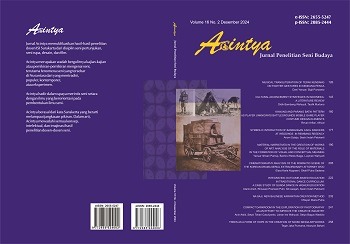MUSICAL TRANSLITERATION OF TEPAK KENDANG ON FIGHTER GESTURES IN KENDANG PENCA
DOI:
https://doi.org/10.33153/acy.v16i2.6756Keywords:
Kendang Penca, Transliteration, Tepak Kendang, Luyu Concept.Abstract
Kendang Penca is an art form that presents a complexity of interactions between the movements of fighters and the patterns of tepak kendang. The interaction between the two shows the connection between the language of movement and the language of music in building the concept of harmonious performance. From this interaction, the phenomenon of transliteration emerges, namely the process of translating the language of motion into the language of music, which in this case is the tepak kendang pattern. This research aims to reveal the process of transliterating the sound of tepak kendang music to martial arts movements in the Kendang Penca performance art. The problem posed is how the tepak kendang pattern and how the transliteration of the tepak kendang sound to the movements of the fighter is carried out. The theoretical concept of transliteration as part of the discipline of philology is used as a theoretical basis for examining research problems, while qualitative research methods with an ethnographic approach are used to guide researchers in extracting data, interpreting, and finding research conclusions. The results of this study reveal that the transliteration process carried out by the rider is framed by the concept of luyu aesthetics, so that the expression of the tepak kendang pattern presented is at the level of the perspective of appropriateness of the community supporting the art of kendang penca.
Downloads
References
Agustina, M. (2014). PENGARUH PHONOLOGICAL AWARENESS DAN KEMAMPUAN PEMROSESAN ORTOGRAFI TERHADAP KEMAMPUAN MEMBACA AWAL SISWA SEKOLAH DASAR. MODELING Jurnal Program Studi PGMI, 1(2).
Amirah Soraya, D. S., Wrahatnala, B., & Putra, R. G. (2023). Teknik Pengembangan Kacapi Siter: Menuju Permainan Kacapi Gaya Baru oleh Yayan Lesmana. Resital:Jurnal Seni Pertunjukan. https://doi.org/10.24821/resital.v24i3.8563
Azzahra, N. R., Kamahidayat, Y., & Suryawan, A. I. (2023). Ibing Penca Baragbag Tengah di Paguron Sinar Pusaka Putra Garut. Journal of Education, Humaniora and Social Sciences (JEHSS). https://doi.org/10.34007/jehss.v6i1.1868
Bangun Prasetyo Widodo, M., & Kasmahidayat, Y. (2023). Ibing Pencak Silat Gaya Cimande di Jampangkulon Kabupaten Sukabumi. Jurnal Sendratasik. https://doi.org/10.24036/js.v12i2.122790
Darusuprapta. (2019). Macapat dan Santiswara. In Humaniora.
Harahap, N. (2021). Filologi Nusantara: Pengantar ke Arah Penelitian Filologi. Prenada Media.
Kamarusdiana, K. (2019). Studi Etnografi Dalam Kerangka Masyarakat Dan Budaya. SALAM: Jurnal Sosial Dan Budaya Syar-I. https://doi.org/10.15408/sjsbs.v6i2.10975
Love, N. (2017). On languaging and languages. Language Sciences, 61, 113–147. https://doi.org/10.1016/j.langsci.2017.04.001
Millie, J. (2004). Three books on the literary tradition of West Java. Bijdragen Tot de Taal-, Land- En Volkenkunde / Journal of the Humanities and Social Sciences of Southeast Asia, 160(2–3), 416–423. https://doi.org/10.1163/22134379-90003731
Mulyadi, T. (2023). Gugum Gumbira and the History of the Creation of Jaipongan Dance. International Journal of Culture and History, 10(1), 21. https://doi.org/10.5296/ijch.v10i1.20670
Mulyadi, T. (2024). PENCAK JAIPONGAN BY CHOREOGRAPHER GUGUM GUMBIRA. Acintya : Jurnal Penelitian Seni Budaya, 16(1), 1–12. https://doi.org/https://doi.org/10.33153/acy.v16i1.6026
Oktriyadi, R., & Sentosa, G. (2023). TEPAK CIWARINGINAN PADA SENI PENCAK SILAT DI KOTA BANDUNG. Paraguna. https://doi.org/10.26742/paraguna.v10i2.2948
Rezhi, K., Yunifar, L., & Najib, M. (2023). Memahami Langkah-Langkah dalam Penelitian Etnografi dan Etnometodologi. Jurnal Artefak. https://doi.org/10.25157/ja.v10i2.10714
Rosaliza, M., Asriwandari, H., & Indrawati, I. (2023). FIELD WORK: ETNOGRAFI DAN ETNOGRAFI DIGITAL. Jurnal Ilmu Budaya. https://doi.org/10.31849/jib.v20i1.15887
Saepudin, A. (2015). Perkembangan dan Perubahan Tepak Kendang Jaipongan Suwanda dalam Masyarakat Urban. Journal of Urban Society’s Arts. https://doi.org/10.24821/jousa.v2i1.1265
Santosa. (2021). Seni sebagai Bahasa: Wittgeinstein, Makna, dan Teori Estetik.
Soemaryatmi, S. (2022). STUDI PUSTAKA TARI SRIMPI MUNCAR GAYA YOGYAKARTA DAN GAYA MANGKUNAGARAN SURAKARTA. Acintya : Jurnal Penelitian Seni Budaya, 13(2), 204–218. https://doi.org/10.33153/acy.v13i2.4123
Sudiana, I. M. (2019). PERSOALAN ORTOGRAFI PENYERAPAN KOSAKATA SANSKERTA DALAM BAHASA INDONESIA. Kadera Bahasa. https://doi.org/10.47541/kaba.v2i2.54
Sugiarta, N., & Lestari, A. (2023). INTERAKSI SIMBOLIK ESTETIKA BENTUK KESUNDAAN MELALUI USIK SANYIRU PADANAN SEBAGAI BENTUK REVITALISASI TRADISI PENCAK SILAT. JISIP (Jurnal Ilmu Sosial Dan Pendidikan). https://doi.org/10.58258/jisip.v7i1.4181
Taryana, D. (2020). TEPAK KENDANG PALERED DALAM IBING PENCAK SILAT DI PERGURUAN TAPAK SEPUH LIGAR SAPUTRA KABUPATEN TASIKMALAYA. Universitas Pendidikan Indonesia.
Wiresna, A. G., Sobarna, C., Caturwati, E., & Gunardi, G. (2020). The relation of kendang and jaipongan: Functions and inspirations of kendang musicality on jaipongan’s journey. Harmonia: Journal of Arts Research and Education. https://doi.org/10.15294/harmonia.v20i2.24953
Zhang, P. (2023). New Media, New Literary Theory, and New Literature from an Interological Horizon. Signs and Media, 2(1–2), 1–22. https://doi.org/10.1163/25900323-12340020
Downloads
Published
How to Cite
Issue
Section
License
Copyright (c) 2025 Dani Yanuar, Sigit Purwanto

This work is licensed under a Creative Commons Attribution 4.0 International License.
Author continues to retain the copyright if the article is published in this journal. The publisher will only need publishing rights




